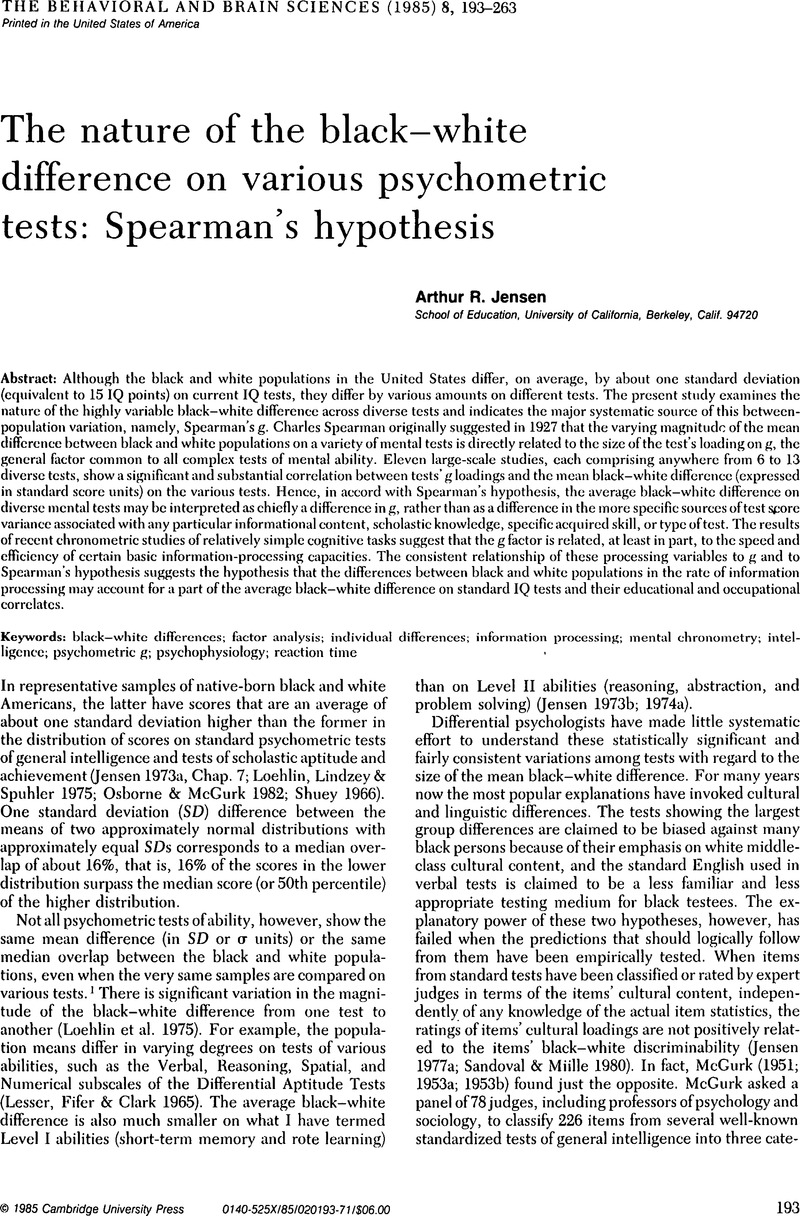Crossref Citations
This article has been cited by the following publications. This list is generated based on data provided by Crossref.
Jensen, Arthur R
1986.
g: Artifact or reality?.
Journal of Vocational Behavior,
Vol. 29,
Issue. 3,
p.
301.
Flynn, James R.
1987.
Measurement, Realism and Objectivity.
p.
1.
Jensen, Arthur R.
1987.
Historical Foundations of Educational Psychology.
p.
61.
Jensen, Arthur R.
1989.
The relationship between learning and intelligence.
Learning and Individual Differences,
Vol. 1,
Issue. 1,
p.
37.
Widaman, Keith F.
Carlson, Jerry S.
Saetermoe, Carrie L.
and
Galbraith, Gary C.
1993.
The relationship of auditory evoked potentials to fluid and crystallized intelligence.
Personality and Individual Differences,
Vol. 15,
Issue. 2,
p.
205.
Jensen, Arthur R.
1993.
Policy Perspectives on Educational Testing.
p.
117.
JENSEN, ARTHUR R.
1993.
Spearman's g: Links Between Psychometrics and Biology.
Annals of the New York Academy of Sciences,
Vol. 702,
Issue. 1,
p.
103.
Jensen, Arthur R.
1994.
Psychometric g related to differences in head size.
Personality and Individual Differences,
Vol. 17,
Issue. 5,
p.
597.
Byrne, Joseph M.
Dywan, Christopher A.
and
Connolly, John F.
1995.
An innovative method to assess the receptive vocabulary of children with cerebral palsy using event-related brain potentials.
Journal of Clinical and Experimental Neuropsychology,
Vol. 17,
Issue. 1,
p.
9.
Deary, Ian J.
and
Caryl, Peter G.
1997.
Neuroscience and human intelligence differences.
Trends in Neurosciences,
Vol. 20,
Issue. 8,
p.
365.
Schepers, J.M.
Todd, A.E.
and
Stuart, A.D.
1999.
Electrophysiological Concomitants of Psychometric Intelligence.
South African Journal of Psychology,
Vol. 29,
Issue. 3,
p.
138.
Byrne, Joseph M
Connolly, John F
MacLean, Shannon E
Dooley, Joseph M
Gordon, Kevin E
and
Beattie, Tricia L
1999.
Brain activity and language assessment using event‐related potentials: development of a clinical protocol.
Developmental Medicine & Child Neurology,
Vol. 41,
Issue. 11,
p.
740.
Helmbold, Nadine
and
Rammsayer, Thomas
2006.
Timing Performance as a Predictor of Psychometric Intelligence as Measured by Speed and Power Tests.
Journal of Individual Differences,
Vol. 27,
Issue. 1,
p.
20.
Nettelbeck, Ted
2011.
The Cambridge Handbook of Intelligence.
p.
371.
te Nijenhuis, Jan
Bakhiet, Salaheldin F.
van den Hoek, Michael
Repko, Jasper
Allik, Jüri
Žebec, Mislav S.
Sukhanovskiy, Vladimir
and
Abduljabbar, Adel S.
2016.
Spearman's hypothesis tested comparing Sudanese children and adolescents with various other groups of children and adolescents on the items of the Standard Progressive Matrices.
Intelligence,
Vol. 56,
Issue. ,
p.
46.
Nijenhuis, Jan te
Choi, Kyu Yeong
Choi, Yu Yong
Lee, Jang Jae
Seo, Eun Hyun
Kim, Hoowon
and
Lee, Kun Ho
2018.
Differences Between APOE Carriers and Non-APOE Carriers on Neurocognitive Tests: Jensen Effects?.
American Journal of Alzheimer's Disease & Other Dementias®,
Vol. 33,
Issue. 6,
p.
353.
te Nijenhuis, Jan
Choi, Yu Yong
van den Hoek, Michael
Valueva, Ekaterina
and
Lee, Kun Ho
2019.
Spearman’s hypothesis tested comparing Korean young adults with various other groups of young adults on the items of the Advanced Progressive Matrices.
Journal of Biosocial Science,
Vol. 51,
Issue. 6,
p.
875.
Nettelbeck, Ted
Zwalf, Oliver
and
Stough, Con
2019.
The Cambridge Handbook of Intelligence.
p.
471.
Azevedo, Nancy
Crestol, Arielle
Berkun, Kathleen
Papathanasopoulos, Alexandra
Yamani, Leen
Rokos, Alexander
Kehayia, Eva
and
Blain-Moraes, Stefanie
2022.
A N400 event-related potential elicitation paradigm for Canadian French speakers*.
The Mental Lexicon,
Vol. 17,
Issue. 1,
p.
104.



